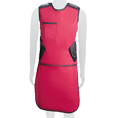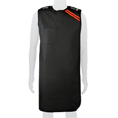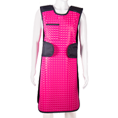- No products in the cart.
27
Jul
Radiation protection of your body and eyes are the most important things to remember to safely perform diagnostic imaging procedures for a long professional life to come. However, the weight of radiation PPE is just as important, given the musculoskeletal problems(1) that are associated with heavy lead aprons which may reduce your ability to work in a diagnostic imaging profession.
This article assists in understanding what are the factors that influence the weight and safety of a lead apron. It advises what questions healthcare professionals should ask the companies who supply radiation PPE to get a truthful answer of the actual weight of a X-ray apron. This will enable you to compare the true weight between various brands.
Healthcare professionals often ask how much does a lead aprons weigh as they often have to wear lead gowns for quite a long time every day, especially during interventional procedures. People usually expect to get a number, such as a medium size weighs 5 kilograms. But is this a true answer? Yes, for a specific brand, but not if you compare lead aprons between different companies. The real weight of a lead apron is much more complex to explain than providing a simple figure in kilograms as this number (5 kg) is not presented in the context of the factors that influence the weight of a lead apron.
A lead apron’s weight is impacted by at least five factors which are:
- Inner protection materials,
- Tested diagnostic imaging range specified in radiation protection standards,
- Lead equivalences (= protection thickness of inner protection materials),
- Sizes (such as cut and length)
- Type of lead apron
1. What inner protection materials are used?
Inner protection materials are materials inside of a lead apron that protect your body against x-ray and scatter radiation. At present, there are three types of protection materials on the market, such as:
| Protection Material | Lead | Lead Composite | Lead Free |
| Consists of | Pure Lead |
Lead and composite materials (aluminium, antimony, barium, bismuth, tin, titanium, or tungsten)
|
Combination of metals like aluminium, antimony, barium, bismuth, tin, titanium, or tungsten. |
| Weight | Heaviest |
Slightly lighter (5-8%) than pure lead
|
Can be up to 30% lighter than pure lead |
| Application Areas | Procedures in Nuclear Medicine, Veterinary, Dentistry | Procedures in Veterinary, Dentistry, Operating Theatres | Procedures in Interventional procedures (e.g Angiography), Operating Theatres |
| Length of procedures | Short | Short to medium | Medium to long |
2. What is the tested diagnostic imaging range of the inner protection materials?
The inner protection materials are required to be tested to block a specific x-ray tube voltage (e.g. 100kVp) and/ or a range (e.g. 50-150 kVp). The diagnostic imaging range refers to the power and strength of the x-ray beam that needs to be blocked by the protection material (lead, lead-composite or lead-free) during diagnostic imaging procedures (e.g. fluoroscopy) to protect healthcare staff. The current required energy range is detailed in country specific and international Radiation Protection Standards.
For example, the Australian and New Zealand Standard (AU/NZS 4543.3-2000) only specifies testing of radiation protection materials at one x-ray tube voltage, e.g. 90 or 100 kVp. This testing method does not take into account the fluorescence and secondary scatter radiation that occurs when working in x-ray operating rooms.
On the contrary, the new international standard IEC 61331.3-2014 specifies testing of radiation protection materials at minimum four x-ray tube voltages, 50, 70, 90 and 110 kVp. Due to a different testing procedure the fluorescence and secondary scatter radiation is detected which increases radiation safety for medical staff and patients significantly. Additionally, when aprons are worn for radiological examinations where there is exposure to higher energy radiation, greater than 125 kV, for example in “in-room CT assist” procedures, protective aprons should also meet the lead equivalent values for radiation quality 150kV.
3. What is the required lead equivalence?
The lead equivalence of an xray gown is basically the protection thickness of the inner protection material. Most commonly available are the thicknesses 0.25, 0.35, 0.50 and occasionally 0.70mm Pb. The higher the value, the thicker and the heavier the protection material will be.
The minimum required lead equivalence is stated in the Radiation Protection Standards:
The Australian/New Zealand Standard (AS/NZS 4543.3:2000) IEC 61331-3:1998 'Protective devices against diagnostic medical X radiation. Part 3: Protective clothing and protective devices for gonads' states the required attenuation equivalent of light protective aprons shall be not less than 0.25mm Pb over entire area. For heavy protective aprons, not less than 0.35mm Pb for the front section and 0.25mm Pb for remaining parts.(2)
Based on this standard, different states and areas of hospitals provide additional radiation safety policies in which different thicknesses are stated.
For instance, according to the Radiation Guideline of the EPA (Environment Protection Authority) in New South Wales, lead aprons require a minimum of 0.30mm Pb at the back.(3)
Always check with your Medical Physicist, Radiation Safety Officer or Chief Radiographer what lead equivalences are required for your department.
4. What is the size of the lead apron? How long are the standard xray gowns?
Just comparing the weight of sizes between different brands is irrelevant because manufacturers of lead aprons vary not only in their size and lengths measurements, but also in using different combinations of inner protection materials which are tested for different diagnostic imaging ranges.
It appears that every manufacturer uses different sizing, meaning a small size lead apron of one brand can be a medium size lead apron of another brand or vice versa.
There are also difference between the lengths of x-ray gowns. e.g. American brands provide lead aprons that are fairly short (above knee) in comparison to European brands that tend to offer longer lead aprons (below knee). The lead apron sizing for European brands is regulated in the document ‘Regulation (EU) 2016/425 (Module B & D).’
It is always recommended to check out the manufacturer’s sizing charts to compare sizes of different brands.
5. What type of lead apron is compared?
Lead Garments are available as:
- Vest and skirt (“two piece apron”) lead aprons providing front and back protection (“wraparound”)
- Wraparound (“one piece apron”) lead aprons offering front and back protection (“wraparound”)
- Front lead aprons (“one piece apron”) providing only front protection Vest/ skirt and wraparound lead aprons are naturally heavier than front aprons as these types offer full front and back protection.
The Area Density – the most accurate way of comparing a lead apron’s weight
You can see that there are at least five factors that influence the weight of a lead garment. With quite a few lead apron manufacturers on the market, how can you compare the actual weight between them?
The most accurate way to compare a lead apron’s weight from one brand with another brand is by Area Density – the minimum mass per unit area of the protection material (defined in IEC 61331.3-2014) required to provide the value of lead equivalent (e.g. 0.50mm Pb) at x-ray tube voltages (e.g. 90 kVp) . The Area Density (weight) is measured in grams (g) or kilograms (kg) per square metre (m2).
Example of how a comparison between brands can look like:
| Brand A | Brand B | Brand C | Brand D | |
|
Protection Materials |
Lead Free | Lead Free | Lead Free | Lead Free |
| Diagnostic Range | 100 kVp | 60-110 kVp | 60-110 kVp | 50-150 kVp |
| Lead Equivalence | 0.50mm Pb | 0.50mm Pb | 0.50mm Pb | 0.50mm Pb |
| Area Density | 2.5 kg/m2 | 2.7 kg/m2 | 2.9 kg/m2 | 3.3 kg/m2 |
| Lightest | Lighter | Lighter | Heaviest | |
| Evaluation |
This company provides the lightest option.
However, this lead apron doesn’t take scatter or fluorescence into account as the apron has only been tested at one diagnostic imaging range.
|
This company offers a lighter option than Brand C and D;
Ideal for theatre, cath lab. This lead garment also takes scatter radiation and/or fluorescence into account as the apron has been tested at several tube voltages.
|
Brand C is lighter than Brand D but heavier than Brand B. Also ideal for theatre, cath lab. This apron takes scatter or fluorescence into account as the apron has been tested at a diagnostic imaging range of 60-110 kVp. |
Brand D provides the heaviest option, but it includes radiological examinations where there is exposure to higher energy radiation (e.g. CT assist procedures). This lead gown has been tested to meet the lead equivalent values for 125 to 150 kVp. |
|
(4) Consider with care. Brand A is the lightest option, but only at one tube voltage, providing less radiation protection. |
(1) Winner
This lead apron is slightly heavier than Brand A, but provides higher radiation protection.
|
(2) Brand C is right behind Brand B, with only 200grams more weight. |
(3) Check with your radiation safety officer if a lead apron with higher kVp is required. Most procedures happen between 60 to 110 kVp. |
Summary
In simple terms, in order to get a true picture of a lead apron's weight, healthcare professionals should always ask for the Area Density of the protection materials in a specific lead equivalence . This is the only way to compare "apples with apples" as factors such as diagnostic imaging range, lead equivalences, size and type of lead garment vary between manufacturers. Before you buy a personal xray gown always ask your Medical Physicist, Radiation Safety Officer or Chief Radiographer what the radiation protection guidelines are within your medical department to understand what the minimum requirements for a lead apron are.
Contact us
Deutsch Medical offers radiation protection aprons in three protection materials that have been independently tested against 60 to 150 kVp. If you have any questions about our lead aprons in general, please feel free to contact us: Phone 1300 766 854 or Email: info@deutschmedical.com.au.
Citations and sources:
(1) Klein LW, Tra Y, Garratt KN, Powell W, Lopez-Cruz G, Chambers C, et al. Occupational health hazards of interventional cardiologists in the current decade: results of the 2014 SCAI membership survey. Catheter Cardiovasc Interv 2015;86:913e24
(2) ARPANSA, Aprons for protection against X-rays, available online: https://www.arpansa.gov.au/understanding-radiation/radiation-sources/more-radiation-sources/aprons-protection-against-x-rays
(3) EPA, Radiation Guideline 4, Compliance requirements for x-ray protective clothing (2018), available online: https://www.epa.nsw.gov.au/-/media/epa/corporate-site/resources/radiation/18p0695-radiation-guideline4-xray-clothing.pdf















